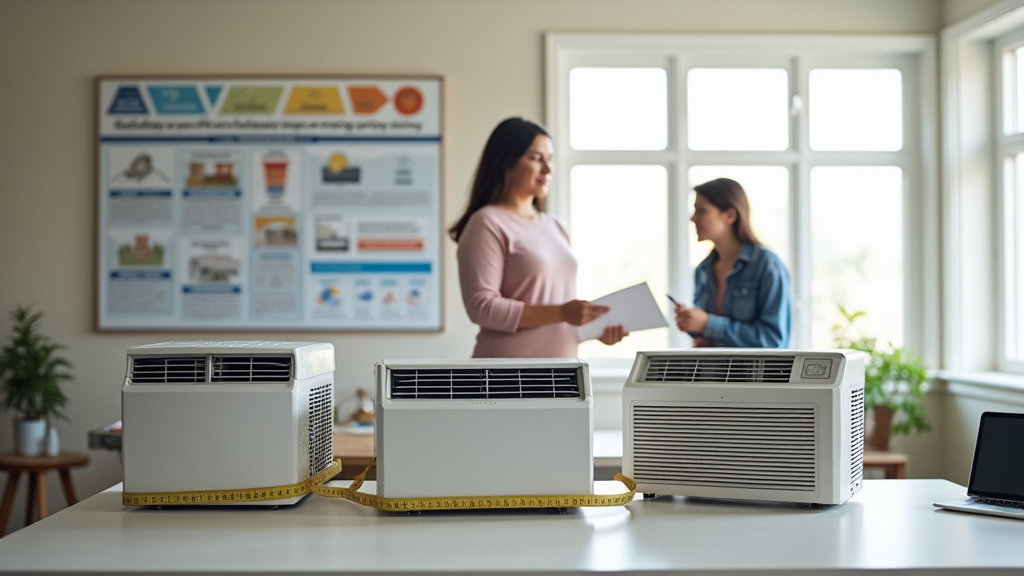When deciding on the right size of an air conditioning (AC) unit for your home, it is important to consider factors like the size of your house, the local climate in Fort Worth, and the specific needs of your family. The goal is to find the right balance so that your AC can cool your home effectively without wasting energy.

When we talk about AC unit size, we usually refer to the unit’s cooling capacity measured in tons. One ton equals 12,000 British Thermal Units (BTUs) per hour. The size of the AC unit should match the needs of your home. If it is too small, it will work harder and use more energy. If it is too big, it may cool too fast without properly removing humidity.
Choosing the right size is crucial for efficiency. A properly sized AC unit:
If you choose an AC unit that is too small, it won’t cool your home effectively. This means:
An oversized AC unit cools the space too quickly. This can lead to:

The first step in choosing the right AC size is measuring the square footage of your home. Here’s a quick guide:
| Square Footage | Recommended AC Unit Size |
|---|---|
| Up to 1,000 sq. ft. | 2.5 ton |
| 1,000 to 1,500 sq. ft. | 3.5 ton |
| 1,500 to 2,000 sq. ft. | 4 ton |
Good insulation helps keep your home cool. Check:
Proper insulation is key to managing your home’s cooling load. If your insulation is lacking, even a larger AC unit may struggle to keep your home comfortable. This can affect your comfort levels and lead to higher costs. Remember, a home evaluation can help identify insulation issues that may need addressing. Seasonal adjustments to your insulation can also help improve system efficiency.
The layout of your home can affect how well the AC cools each room. Consider:
Window placement is also important. Rooms with large windows may heat up faster, so you might need a more powerful unit there. If you have a ductless AC system, it can be a great option for cooling specific areas without the need for extensive ductwork. This can be especially useful in homes with unique layouts. Also, think about airflow; good airflow helps distribute cool air throughout your home. You might also want to consider creating cooling zones in your house to enhance comfort levels. Zoning systems can help manage different temperatures in various areas of your home. Be sure to check customer reviews of different units and comparison shopping can help you find the best options among various air conditioner brands to fit your needs.
Once you have your square footage and layout ready, the next step is to calculate the necessary BTUs. A simple formula is:
This means:
After figuring out the rough size you need, consulting with a qualified technician can help fine-tune your choice. They can perform:
This is especially important in Fort Worth, where the local climate can significantly impact your cooling needs. They can also help you understand the noise levels of different units, which can affect your comfort at home. Be sure to ask about installation tips and processes, as these can vary based on the type of unit and the complexity of the installation. Professional installation is crucial to ensure your unit works efficiently. Additionally, they can help you understand system compatibility with your existing setup.
Finding the right installation company is just as important. Look for:
Make sure the company you choose follows manufacturer guidelines for installation. This ensures that your unit performs well and lasts longer. If you are considering retrofitting your current system, a professional can help you understand the best options available. They can also provide insights on advanced features that can enhance your system efficiency. Ask for contractor recommendations from friends or family to find reliable services.
When selecting an AC unit, energy efficiency ratings are key. The Seasonal Energy Efficiency Ratio (SEER) measures how efficiently an AC unit uses energy. A higher SEER rating means lower energy bills. In Texas, it’s smart to look for units with a SEER of at least 14 or 15. Additionally, consider units with an Energy Star rating for even better efficiency.
SEER rates how much cooling a unit provides for each dollar spent on electricity. More efficient units mean cooler homes and lower bills. This is particularly important when considering energy consumption during the hot summer months.
BTU stands for British Thermal Unit, which measures energy. The more BTUs your AC unit has, the more cooling power it offers. For example, a 2.5 ton unit has 30,000 BTUs, while a 4 ton unit offers 48,000 BTUs.
Many homeowners make mistakes when sizing their AC units. Here are a few common errors:
When selecting an AC unit, consider these additional factors for optimal performance:
| Additional Factors | Impact on Cooling Needs |
|---|---|
| Local energy costs | Higher costs may justify efficiency investments |
| Home orientation | South-facing homes may require more cooling |
| Appliance heat output | Extra cooling needed for high-output appliances |
| Usage patterns | Rooms used more often may need better cooling |
If you are considering window units, they can be a good option for smaller spaces or specific rooms. However, they may not be as efficient as central air systems for larger homes. You might also want to think about adding a dehumidifier to help manage humidity levels, especially during the hot summer months. Additionally, explore upgrade options for your current system if it is outdated or inefficient. Regular seasonal adjustments and maintenance can also help keep your AC running smoothly and efficiently.
Consider investing in a remote control system for your AC unit. This can make it easier to adjust the temperature from anywhere in your home, enhancing your comfort. If you are looking into a heat pump, it can provide both heating and cooling, making it a versatile choice for year-round comfort. Also, keep in mind the environmental impact of your choices. Selecting energy-efficient models can help reduce your carbon footprint while saving you money in the long run.
When you are ready to make a purchase, remember to do some comparison shopping among different air conditioner brands. This will help you find the best unit that meets your needs and budget while also considering the environmental impact of your choice.